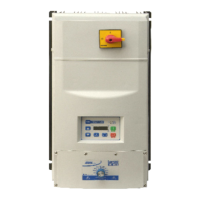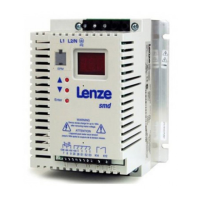68 Lenze SMVector 13554876 EDBSV01 EN v21.0
3.1.3 Steps for Commissioning the Drive for PID Loop
1. Adjust setpoint (for example with the keypad) to desired level.
2. Monitor the PID feedback (P522 if sensor is wired to TB5 and P523 if sensor is wired to TB25)
3. Tune using the following parameters: P207 (p-gain), P208 (I-gain) p209 (D-gain).
4. To tune a PID loop we recommend use of the Ziegler-Nichols method.
StartbyrstsettingtheKi(integral)andKd(derivative)gainstozero.TheKp(proportional)gainisthenincreased
(from zero) until it reaches the point at which the output of the control loop oscillates with a constant amplitude.
This point is the Ku (ultimate) gain. At this point the Tu (oscillation period) is used in conjunction with the Ku to
calculate the appropriate gain settings:
Control Type Kp Ki Kd
P 0.500 * Ku - -
PI 0.454 * Ku 0.833 * Tu -
PID 0.600 * Ku 0.500 * Tu 0.125 * Tu
Some Overshoot 0.333 * Ku 0.500 * Tu 0.333 * Tu
No Overshoot 0.200 * Ku 0.500 * Tu 0.333 * Tu
Centrifugal Pan/BlowerMotor
VFD Output
Feedback
Internal PID
Setpoint Referrence
Transducer/Sensor
P
Error
I
D
Run/Stop Run/Stop
External supply
4 – 20 mA
Transducer
4 – 20 mA
Transducer
GND
VCC
OUT
GND
VCC
OUT
1. Connect your analog feedback signal (4-20 MA) between TB25 and TB2 on the drive. The SMV has a built-in
12v 50mA power supply that can be utilized to power the transducer. If the sensor requires higher voltage
or current, an external supply must be used. A 0-10Vdc signal can also be used instead and would be wired
between TB5 and TB2 on the drive.
2. Connect a jumper between TB13A and TB4.
3. Wire your Run/Stop contact between TB1 and TB4 as shown.
3.1.2 Steps for Wiring the Drive for PID
Typical PID Flow Diagram

